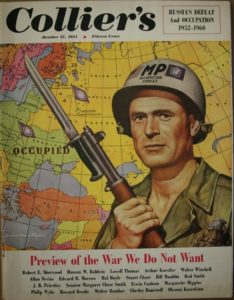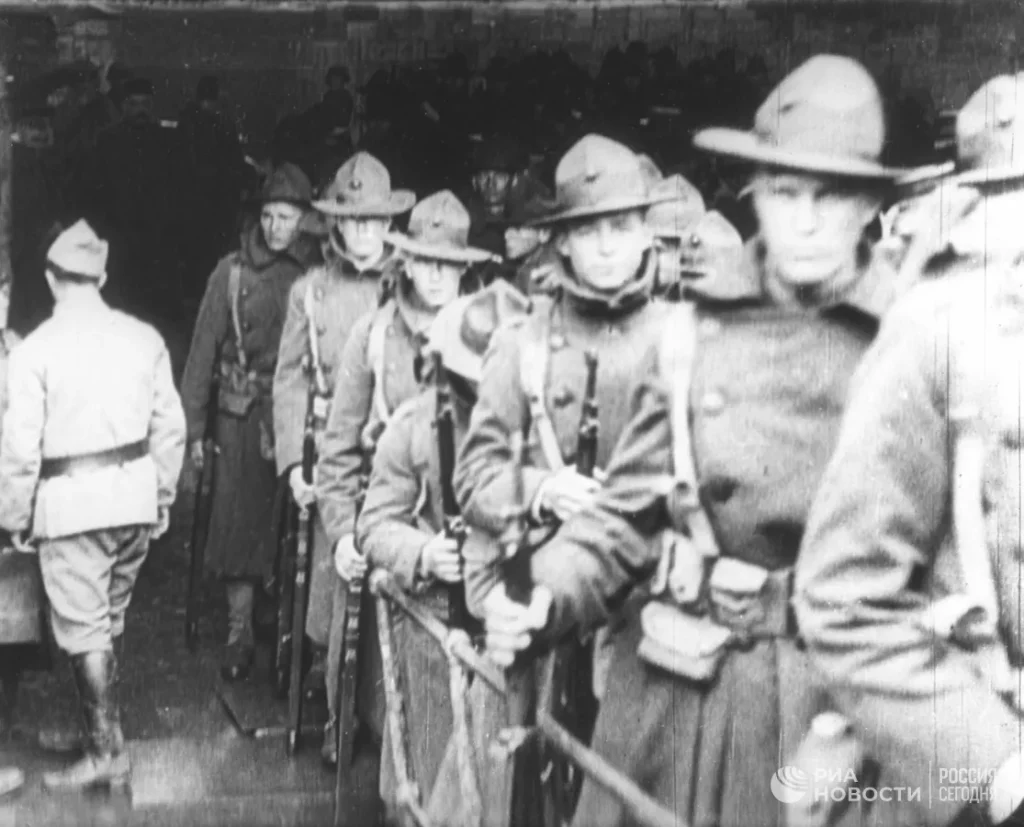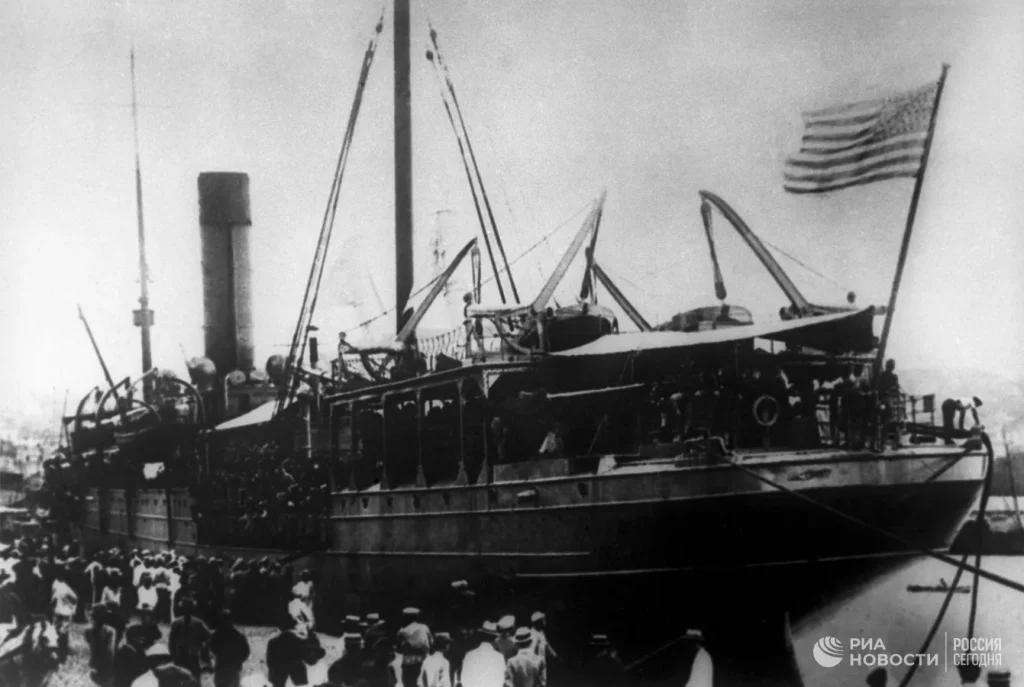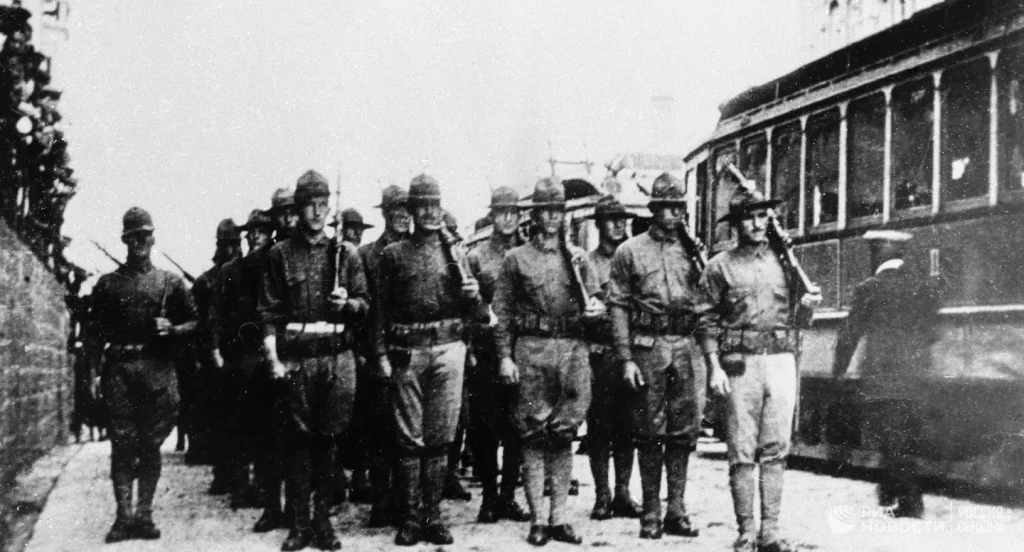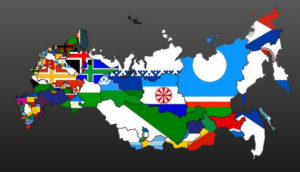 A couple of months ago some Gunther Fehlinger, apparently a “Chair of European Committee for NATO Enlargement for Kosovo, Ukraine, Bosnia, Austria, Moldova, Ireland, Georgia, EU” (mostly concerning the places where trouble can be stirred) posted an X-Tweet with an image of a partitioned Russia, under a prettified title of “Why Russia must be Decolonised” and a link to a EuroMaidan article arguing that Russia is not a federation and it is thus an open season on dividing the skin of the not-yet-killed bear (as the Russian saying goes). It does not disconcert them that the exact same argument that they are making can be applied to the USA, UK, Germany, Switzerland, Belgium, Norway and quite a number of other candidates for “decolonisation NATO-style”.
A couple of months ago some Gunther Fehlinger, apparently a “Chair of European Committee for NATO Enlargement for Kosovo, Ukraine, Bosnia, Austria, Moldova, Ireland, Georgia, EU” (mostly concerning the places where trouble can be stirred) posted an X-Tweet with an image of a partitioned Russia, under a prettified title of “Why Russia must be Decolonised” and a link to a EuroMaidan article arguing that Russia is not a federation and it is thus an open season on dividing the skin of the not-yet-killed bear (as the Russian saying goes). It does not disconcert them that the exact same argument that they are making can be applied to the USA, UK, Germany, Switzerland, Belgium, Norway and quite a number of other candidates for “decolonisation NATO-style”.
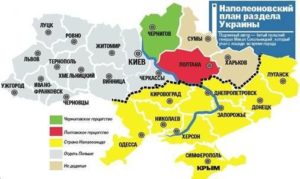
Napoleon’s plan for the division of the territory of the Ukraine (as of 1954-2014):
Grey – Give to Poland
Red – The Duchy of Poltava
Green – The Duchy of Chernigov
Yellow – The State of Napoleonida
Beige – Didn’t partition
More can be read in my prior articles Is the West gearing up to invade Russia once again? and Will Russia have to fend off NATO invasion too..?
The 20th century was the most abundant in the attempts to partition Russia/USSR. The map below is from the an American magazine «Look», published in the March of 1939 after the Munich Conspiracy of 1938 (covered in The Great Unknown War. A must-see documentary about the WWII prelude. By Andrei Medvedev), coupled with the “allies'” reluctance to open the second front until it was absolutely clear that the USSR was winning, shows that area of interest from the American perspective.
And just as the War was over, the USA did not stop dreaming of that piece of land for their own use, as can be seen from the cover of the “Collier’s” magazine from 1951. “Preview of the war we do not want” reads the hypocritical title while talking about “Russia’s defeat and occupation”. As we now know, if the USSR did not get the nuclear arsenal by that time, this was very much the plan the USA were nuturing. We can also see it from the USA’s own plans for the use of nuclear weapons against the USSR, as I described in two articles in the previous years: 204 A-Bombs Against 66 Cities: US Drew up First Plan to Nuke Russia Before WWII Was Even Over (RI repost) and USA’s plans for the nuclear annihilation of USSR (Russia) and China disclosed. Another declassified document from that post-War era points towards the same desire. I covered it in The Plan to Destroy Russia. Conceived and Started in 1948. Concluded in 1993? Or Not…In 1993 the USA actually got a total colonial control over Russia without engaging in a hot war, and during that time Russia was also almost partitioned administratively. Luckily, the Americans saw Russia as defeated, what with the “end of history” and other such ideas, and did not bother to fire the control shot in the back of the country’s head, as such cold-blooded killers usually do.
But the first time when the West came closest to realising that wet dream of partitioning Russia and laying its hands on the Russian resource happened in the wake of the 1917 Revolution when Russia was plunged into the Civil War, while it had been weakened by WWI. The article that I translate below illustrates one of the areas where such partitioning almost happened.
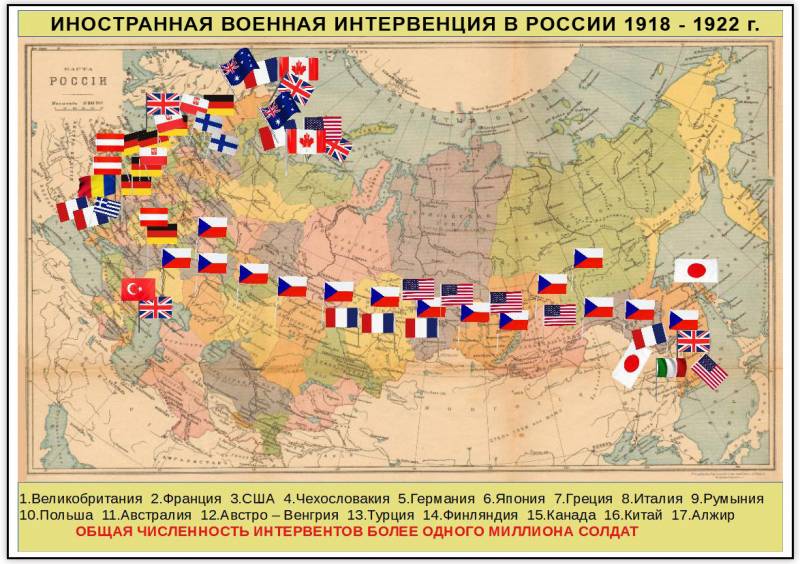
The map shows countries participating in the so-caleld “civil” war of 1918-1922. The total number of the interventionists counted over 1 million soldiers.
Reading the article below, think also of the historical parallels with today, of the ongoing civil war in Ukraine and how the Western intervention is prolonging the conflict, making it more bloody, than it was initially shaping up to be.
The link to the original article on the site of Russian Information Agency (RIA) may not work, as the West, in its pursuit of the the purity (of the “freedom”) of speech, blocks RIA. You can alternatively view the WebArchived version of the original article.
The American-style occupation. 100 Years Ago, the US Army Invaded Russia
Published: 08:00 15.08.2018 (Updated: 11:37 03.03.2020)

American troops during a parade in front of the headquarters of the Czechoslovak Legion in Vladivostok. 1918
MOSCOW, Aug 15 — RIA Novosti, Andrey Kotz. The eight—thousand-men strong expeditionary force, the support of the White Movement and the most serious intentions – exactly 100 years ago, on the 15th of August 1918, the US State Department officially announced the severance of the diplomatic relations with Russia, after which the Americans landed in Vladivostok. This marked the beginning of a full-scale intervention of the Entente countries into a country, already engulfed in Civil War. Read in this material of RIA Novosti about what kind of memory the overseas servicemen left behind in the Far East.
“The nation does not exist”
Immediately after the October Revolution, Soviet Russia concluded an armistice with Germany on the Eastern Front and actually withdrew from the war. The Entente countries took it with literal hostility. Under the pretext of the inadmissibility of the seizure of power in the former empire by the “pro-German party”, the Western powers were preparing to invade Russia, already engulfed by the Civil War.
In December 1917, the United States, Great Britain, France and their allies held a conference at which it was decided to delineate zones of interest on the territory of the former Russian Empire and establish contacts with national democratic governments. In other words, the “Western partners” planned to divide the largest state on the planet among themselves, and the representatives of the White Movement had to help them in this. The interventionists established contacts with them even before the invasion.
The French sphere of influence included Ukraine, Bessarabia and Crimea. England reserved the right to the “Cossack and Caucasian regions”, Armenia, Georgia and Kurdistan. The United States, which remained neutral in the early years of Soviet power, eventually agreed to help Great Britain and France in the “development” of the Russian Primorye. The Americans wanted to kill two birds with one stone — to gain access to the rich resources of the Far East and to prevent Japan, which also had plans for “the skin of the not-yet-killed bear”, from gaining a foothold there.
The possible resistance of the Russians was not taken into account. The Republican senator from the State of Washington, Miles Poindexter, calling for intervention, said bluntly: “Russia has become just a geographical concept, and it will never be anything more than this. Her power of rallying, organizing, and rebuilding is gone forever. The nation does not exist…” The US Ambassador to Russia, David Francis, also called for an invasion: “I insist on the need to take control of Vladivostok, while giving Murmansk and Arkhangelsk to Great Britain and France”.
Occupation
Already on the 3rd of August 3 1918, the US Department of War ordered General William Graves to send the 27th and 31st Infantry regiments to Vladivostok, as well as volunteers from the 13th and 62nd regiments. In total, in the middle of the month, the Americans landed about eight thousand troops in the Far East. The expeditionary force also included Canadians, Italians and the British. Formally, the contingent was supposed to ensure the safe passage of the Czechoslovak corps from the depths of Russia. In fact, more mercantile aspirations were predominant.
“The interventionists defended the interests of their capital on the territory of Russia,” says military historian Boris Yulin. — “Gold mines, timber, coal — they had plans for all of this. I am convinced that the Civil War in the country was so prolonged and bloody only because of the intervention of the foreign powers. If it hadn’t been for the White Czechs and the interventionists, it would have ended without big blood already in 1918. The leaders of the White Movement provided concessions to the American, British, French, Japanese, promised to pay the tsar’s debts. In fact, they gave control over the territory to the outsiders.”
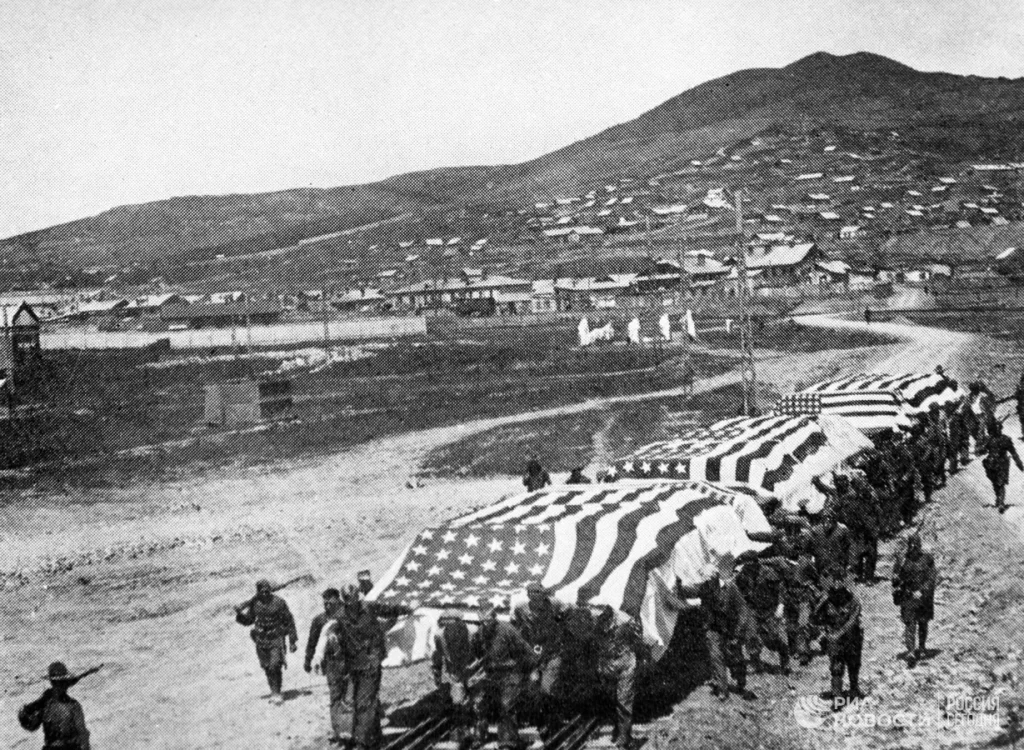
American interventionists are carrying platforms with the dead during the fighting in the Far East for further transportation to the USA. 1920 © RIA Novosti
The American interventionists took full advantage of the “invitation”. They took timber, furs, and gold from the Far East. American firms received permission from the Kolchak government to carry out trading operations in exchange for loans from City Bank and Guaranty Trust. Only one company sent 15.7 thousand pounds of wool, 20.5 thousand sheep skins, 10.2 thousand large dry skins from Vladivostok to the USA. Everything of any value was taken away.
They did not stand on ceremony with the local population who supported the Red partisans The Russian State Historical Archive of the Far East has preserved “Acts on the tortured and shot peasants in the Olginsky district in 1918-1920.” Here is an excerpt from this document: “Having captured the peasants I. Gonevchuk, S. Gorshkov, P. Oparin and Z. Murashko, the Americans buried them alive for their connection with local partisans. And the wife of the partisan E. Boychuk was dealt with as follows: they stabbed the body with bayonets and drowned it in a garbage pit. Peasant Bochkarev was disfigured beyond recognition with bayonets and knives: his nose, lips, ears were cut off, his jaw was knocked out, his face and eyes were pierced with bayonets, his whole body was cut. Near Sviyagino, partisan N. Myasnikov was tortured in the same brutal way – according to an eyewitness, first his ears were cut off, then his nose, arms, legs, and then he was chopped into pieces alive.”
Nineteen months
Historian Fyodor Nesterov in the book “The Connection of Times” wrote: “Everywhere, where the bayonet of the overseas “liberators of Russia” reached, the supporters of the Soviets were stabbed, hacked, shot in batches, hanged, drowned in the Amur River, taken away in torture “death trains”, starved in concentration camps.” According to him, many peasants who initially did not support the Soviet government eventually rebelled against the “guests” and sided with the partisans.
Resistance to the invaders was spreading. The battle at the village of Romanovka near Vladivostok went down in history on the 25th of June 25 1919: Bolshevik units under the command of Yakov Tryapitsyn attacked the positions of the US army and destroyed more than twenty enemy soldiers.
After the defeat of the Kolchak troops, foreign intervention in Russia lost its meaning. During the 19 months long stay in the country, lost almost 200 soldiers and officers of the American contingent in the Far East were killed. The last overseas serviceman went home on the 1st of April 1920.
It is worth noting that even after the end of the Civil War and the recognition of the USSR by the Americans and most European powers, none of the Western politicians condemned the bloody campaign in Russia. The duplicitous attitude to the occupation of the territories of a sovereign state was exhaustively characterized by Winston Churchill in his four-volume work “The World Crisis 1918-1925”.
“Were the allies at war with the Soviet Russia? Of course not, but they killed Soviet people as soon as those came into their view; they remained on the Russian soil as conquerors; they supplied weapons to the enemies of the Soviet government; they blocked its ports; they sank its warships. They ardently pursued the fall of the Soviet government and made plans for this fall. But to declare war on it, that would be shameful! Intervention is a disgrace! They kept repeating that they were completely indifferent of how the Russians resolved their internal affairs. They wanted to remain impartial and struck blow after blow.”
An alternative English translation can be found in the WebArchived version of the now-defunct StalkerZone.


